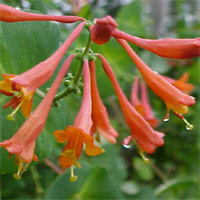Honeysuckle

There are numberous types of honeysuckles. Most are either large shrubs or twining vines that are noted for their colorful, trumpet-shaped flowers, sweet scent, and attractiveness to butterflies and hummingbirds.
About This Plant
Honeysuckle flowers are magnets for hummingbirds; flower colors include orange, red, yellow, and white, depending on the species and variety. Most shrub honeysuckles grow 6 to 15 feet tall and wide, while the vining types grow 10 to 20 feet tall. Honeysuckles bloom in spring to midsummer. Vining forms, such as trumpet honeysuckle (
L. sempervirens), grow well on fences, trellises, and walls with support. Shrub forms, such as winter honeysuckle (
L. fragrantissima), make good hedges, screens, and mass plantings. Honeysuckles tolerate shade and are often seen as an understory plant in the forest. Some species, such as tartarian honeysuckle (
L. tatarica) and Japanese honeysuckle (
L. japonica) , are very aggressive and should be avoided.
Special Features
Fragrant
Attracts hummingbirds
Site Selection
Select a site with full sun to shade and moist, well-drained soil. The plants will flower more profusely in full sun.
Planting Instructions
Plant in spring or fall. Space plants 5 to 15 feet apart, depending on the expected mature size of the plant. Dig a hole only as deep as the root ball and 2 to 3 times as wide. If your soil is in very poor condition, amend the soil you've removed from the hole with a small amount of compost. Otherwise don't amend it at all. Carefully remove the plant from the container and set it in the hole. Fill the hole half full with soil, then water it well to settle the soil and eliminate air pockets. Let the water drain, then fill the remainder of hole with soil and water thoroughly.
Care
Apply a layer of compost around the base of the plant each spring, followed by a 2-inch layer of mulch to retain moisture and control weeds. Water plants during the summer if rainfall is less than 1 inch per week. Prune shrubs and vines after flowering. Aggressive varieties can be pruned back to the ground in late winter to control growth.






 There are numberous types of honeysuckles. Most are either large shrubs or twining vines that are noted for their colorful, trumpet-shaped flowers, sweet scent, and attractiveness to butterflies and hummingbirds.
There are numberous types of honeysuckles. Most are either large shrubs or twining vines that are noted for their colorful, trumpet-shaped flowers, sweet scent, and attractiveness to butterflies and hummingbirds.